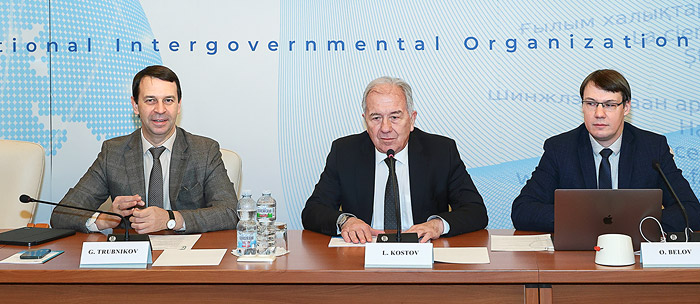
Electronic english version since 2022 |
The newspaper was founded in November 1957
| |
|
Number 4 (4752) |
At the PAC meetings
Reactor in focus
On 27 January, the 60th meeting of the Programme Advisory Committee for Condensed Matter Physics was held in a mixed format.
It opened with information from the PAC Chairman Denes Nagy on the implementation of the recommendations of the previous meeting of the Programme Committee. Latchesar Kostov informed the participants about the resolution of the 136th session of the Scientific Council and the decisions of the PAC (November 2024).
Egor Lychagin gave a report "On the status of IBR-2 as part of the reactor's preparation for launch" at the meeting.
- I briefly informed the PAC members about the current situation with preparations for the reactor launch. The reactor has not been operating for the last three years, our license expired and we have been preparing for a long time to obtain a new one. Unfortunately, today, the examination of documents in Federal Service for Environmental, Technological, and Nuclear Supervision of Russia takes a long time. After we had obtained the license, we had to meet some technical issues: we changed some equipment at the reactor. Today, this all work is completed. At the end of the year, a change to the license conditions was obtained and currently, we have the opportunity to launch the reactor with full power. I said that a test cycle is scheduled for mid-February, in which we will study how the reactor operates after a long shutdown (these are routine procedures that we periodically carry out at the reactor). Experimenters will also have the opportunity to configure and test their experimental equipment. If the test cycle is completed successfully, then in spring, we will organize two standard cycles for experimenters from JINR, as well as for external users via the fast access system to beams. In spring, we will make an announcement that the reactor operates and applications can be submitted for experiments for autumn of 2025.

It is important for physicists that neutron fluxes are as high as possible. We currently try to order a new fuel load from Rosatom enterprises. It will allow us to increase the reactor's power, for over the course of the reactor's operation, the fuel properties change and we have to reduce the power.
In your report, you complained that there are not enough experts involved in selecting proposals for the experiment. And D.Nagy spoke on this matter.
- Denes suggested posting information about the search for experts on the website. Perhaps, we should search for them more widely, not only through our channels, but in various communities that include specialists involved in neutron scattering. I expected more active participation from the Committee members. Last time, we asked them to recommend candidates to us. Perhaps, because most of the foreign members of the PAC are representatives of Europe, for political reasons, it is difficult for their colleagues to participate in the work of our expert groups.
Maxim Bulavin delivered the report "Development of a mathematical model for the dynamics of fast pulsed reactors: results and plans" and Denis Kozlenko gave the report "The spectrometers complex of the IBR-2 reactor: current status and recent developments".
Commenting on M.V.Bulavin's report and the discussion that followed, FLNP Chief Researcher Viktor Aksenov said the following to our weekly:
- Instability of power pulse oscillations is a feature of the IBR-2 and IBR-2M reactors, caused by their design. Because of it, as the fuel burns up, it is necessary to reduce the power and the neutron flux decreases accordingly. The main parameters by which the behavior of the reactor is controlled are power, coolant delivery rate and the degree of fuel burnup. However, the other parameters and there are many of them, are hidden in the reactor design and have not been understood until recently. Therefore, any attempts to repeat the design principles of IBR-2 with a plutonium core and a movable reflector will result in even more unpredictable behavior of the reactor.
Evgeny Shabalin, based on a long-term (since the mid-1980s) analysis of reactor operation, proposed considering the main processes, in his opinion that in recent years have been described using a mathematical model (see No.2 of the weekly). This model, in contrast to the currently used phenomenological approach, explains the nature of the unavoidable instabilities of the IBR-2M reactor, allows consciously optimizing its operating modes and provides a theoretical justification for the design of the new reactor.
A fundamentally new design is proposed in the NEPTUN reactor project that is free of the main drawback of the IBR-2 reactor and has better output characteristics. The project contains new ideas, new technologies and new opportunities for physicists.
Scientific reports at the PAC meeting were given by I.Yu.Zel ("Neutron tomography for structural analysis of cement materials, rocks and meteorites") and H.Isavi ("Analysis of the conformational dynamics of the Aβ42 peptide in lipid membrane mimetics: spectroscopic and atomistic investigation").
Poster reports were presented by young scientists from FLNP, MLIT, DLNP and BLTP. The winners were: A.V.Rutkauskas ("Structural and vibrational properties of francisite Cu3Bi(SeO3)2O2Cl at high pressure"), D.R.Badreeva ("Impact of phospholipid composition on the interaction of the membrane with beta-amyloid peptide in the framework of molecular dynamics simulation"), M.M.Avdeev ("Polymer brushes synthesized by surface grafting: surface characterization and scaling analysis").
Olga TARANTINA,
photo by Igor LAPENKO